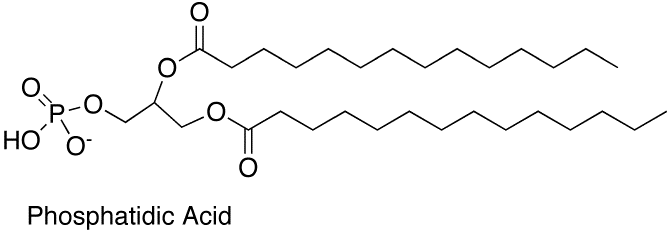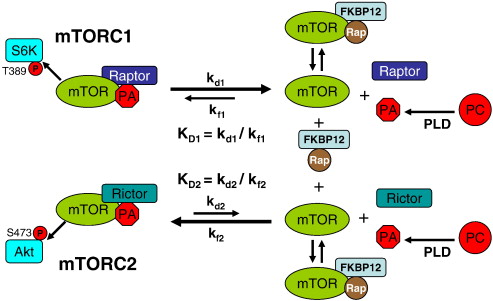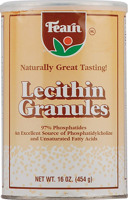There's a new, all-natural ingredient that is making waves in the bodybuilding world and it could be a very big deal! Yes, we're bamboozled with countless new products each and every year that promise unreal muscle gains but are really nothing but hyperbole.
The researchers at Chemi Nutra (A subsidiary of Italian pharmaceutical company ITALIFARMCO) have stumbled upon a novel ingredient, phosphatidic acid.[1]
What separates phosphatidic acid from many of the other pretenders on the market is that it has human research trials demonstrating increases in strength and lean body mass and decreases in fat!
Let's find out more about what this beauty is:
What is Phosphatidic Acid?
Phosphatidic Acid is a phospholipid, a diglyceride fat with a phosphate group bonded to the glycerol backbone. Phospholipids are a major constituent of cell membranes, and influence a number of mechanisms in cell metabolism.

The company behind PA
In Chemi Nutra's case, they are extracting their phosphatidic acid from lecithin, a major source of many various phospholipids such as one of their other patented ingredients, phosphatidylserine.
Before we get into the details, you can see some of the Phosphatidic Acid-based products below and sign up for price drop alerts since they're still expensive.
Phosphatidic Acid – Deals and Price Drop Alerts
Get Price Alerts
No spam, no scams.
Disclosure: PricePlow relies on pricing from stores with which we have a business relationship. We work hard to keep pricing current, but you may find a better offer.
Posts are sponsored in part by the retailers and/or brands listed on this page.
But keep reading, because at the bottom of this post, we show an incredibly effective way to get PA for a fraction of the price!
Now let's get into the details:
How does it work?
We all understand that muscles grow as a response to lifting, but how does this work?
Scientists have identified a protein named "mammalian target of rapamycin" -- or mTOR for short -- as a key regulator of this muscle growth. The term for this is 'mechanically-induced mTOR signalling'.
Over the past few years as a result of this expanded knowledge of the mechanical functions behind muscle growth you've probably seen a lot of supplements talking about increasing mTOR signalling, with varying levels of success.
So, what does this have to do with phosphatidic acid?
Researchers weren't satisfied with simply knowing that mechanical signalling of this protein causes muscle growth, they wanted to know exactly what is involved in that signalling.
Enter Troy Hornberger at the University of Wisconsin.[2]
Through a fascinating series of research (if you're a science junkie that is) using live cellular level imaging of muscle cells under contraction, the pathway and compound directly responsible for mechanical-induced mTOR signalling were identified as an enzyme phospholipase D, which degrades phosphatidylcholine into choline and phosphatidic acid, which directly activates mTOR.[3-10]
We're already huge fans of choline supplements - they are cognitive enhancers that help improve the "mind-muscle" connection when working out. But now will supplementing PA also help directly fuel mTOR signaling?
Various Sources
Although there are several sources of soy and egg-based derivatives of phosphatidic acid, the outcomes of the clinical trials show that soy-based PA sources are the most effective.[11]
What are the benefits?
These breakthroughs in our understanding of muscle growth and mTOR signalling have led to a great deal of interest in how to apply this new knowledge to humans, as a potential treatment for diseases and for use in enhancing sports performance. This led to programs such as UCF's Human Performance Lab to conduct studies in humans.
-
High Bioavailability
Of utmost importance when determining the usefulness of a compound for supplementation is determining if it is bioavailable, and can reach the desired tissues intact. In a study on humans, it was determined that phosphatidic acid has a high oral bioavailability in humans and increases plasma phosphatidic acid levels effectively.[12]
-
Increase Strength
In the first human study, trained athletes were given 750mg of phosphatidic acid daily for 8 weeks and followed a rigid resistance training program. At the end of the trial, the supplementation group gained 12.7% squat strength (9.3% for placebo) and a 2.6% increase in lean body mass (0.1% for placebo).[13]
The study subjects consumed nearly identical calories over the course of the study. This study was a small one, and these benefits were not large enough to be deemed statistically significant due to those limitations, however they did generate enough interest to justify further human study.
-
Increase Lean Mass Gains
In the next human study, following the same protocols (750mg daily, resistance trained athletes, 8 weeks), the phosphatidic acid again performed well. The supplement group ended off with significantly better lean body mass gains, adding 5 pounds of muscle compared to the controls 2.5 pounds.[14]
Additionally, there was a statistically significant increase in leg press over control with the supplement group adding 115 pounds and the control just 70.
-
Enhance Fat Loss
Another trend that was noted, albeit not statistically significant was one of increased fat loss in the supplement group vs. the control group(-2.8 lbs compared to -1.1 lbs).[14] Although this isn't a huge difference in weight loss by any stretch of the imagination, any increased fat loss from a supplement is better than no fat loss!
-
Stress Reduction
In another study, this time using soy lecithin as the source for PA, individuals were administered PA derived from cow brains (doesn't that sound appetizing) in various amounts from 0-800mg.
The group that received the 400mg dose showed marked improvements in reducing cortisol levels and no rise in heart rates.[15] Dosages higher and lower than this, did not elicit the same benefit.
Note, however, that supplements made from bovine brain tissue are very hard to find, and we don't recommend them. The main reason is unfortunately due to Mad Cow Disease, which occurred in a different bovine-based supplement, the cognitive enhancer phosphatidylserine.[16]
So take this stress reduction study with a grain of salt - it was done using a form of the supplement that you won't get your hands on (and likely won't want to risk).
Dosage
To reap the benefits PA has to offer, you would want to get the full 750mg dose that was used in the clinical trials. This ensures activation of the mTOR pathways that was discussed in detail above.
A side note here, is that based on several anecdotal accounts, there have been reports of increase muscle fullness and strength gains when supplementing up to 1.5-2g phosphatidic acid.
PA Products & Supplements
Several supplements have started to hit the market this year that contain the clinical efficacious dose of 750mg Mediator PA. We're positive more are going to flood the supplement scene, but the first ones to debut are:
-
Outbreak Nutrition Build
With more than just PA, Outbreak Nutrition's BUILD supplement is a next-gen muscle-builder we love!
Outbreak Nutrition BUILD – Deals and Price Drop Alerts
Get Price Alerts
No spam, no scams.
Disclosure: PricePlow relies on pricing from stores with which we have a business relationship. We work hard to keep pricing current, but you may find a better offer.
Posts are sponsored in part by the retailers and/or brands listed on this page.
-
Bulk soy-lecithin granules
Unfortunately, most products don't state the exact dose of PA inside, so you're left to guess here.
Soy Lecithin – Deals and Price Drop Alerts
Get Price Alerts
No spam, no scams.
Disclosure: PricePlow relies on pricing from stores with which we have a business relationship. We work hard to keep pricing current, but you may find a better offer.
Posts are sponsored in part by the retailers and/or brands listed on this page.
But that brings up the next product:
-
Fearn Lecithin Granules
Take a look at this label from Fearn's lecithin-based product. Notice something awesome there?
That's right - a single serving of this contains 1200mg PA - more than enough for our goals, plus the other beneficial compounds!
Fearn Lecithin granules are pure lecithin. They contain 97% phosphatides, which just so happens to be the highest concentration of phosphatides found in natural food sources. Additionally, they are a great source of essential fatty acids and our bodies to digest fats more easily.
Fearn Lecithin Granules - Best way to get Cheap PA
Get Price Alerts
No spam, no scams.
Disclosure: PricePlow relies on pricing from stores with which we have a business relationship. We work hard to keep pricing current, but you may find a better offer.
Posts are sponsored in part by the retailers and/or brands listed on this page.
How is this possible?
The word on the street is that once Chemi Nutra's patent fell, the floodgates opened for marketing lecithin for PA content. No matter how or what happened, we can now see how much is in this product, and Fearn was first to jump on the opportunity.
A note here, just as with Carnosyn Beta-Alanine, Mediator's Phosphatidic Acid is the only brand of PA being sold that has the studies to prove it's anabolic effects. Make sure if you do decide to try out a phosphatidic acid supplement, it has the Mediator logo on the label somewhere and you weren't bamboozled into buying some cheap knock-off!
Consider saving money with Fearn
With that said, if you're interested in trying PA and are on a budget, the Fearn product is definitely a great way to get started.
See the price comparisons above and you'll agree!
Any Side Effects?
The next thing you're probably wondering is whether or not this ingredient is safe to take.
Fortunately, as the backers of this ingredient are seeking FDA approval, and a patent on this ingredient, they also performed a safety analysis in humans, concluding that there were:
"no differences at baseline in blood chemistry and hematology between the CON and EXP supplemented groups" and "no differences were observed in urinalysis values between the groups"[11]
So far, it is looking very safe and side-effect free, and that's been supported by the numerous anecdotal discussions happening online.
Wrap Up
Phosphatidic Acid does appear to be a worthwhile supplement to add to your ever-growing arsenal of proven muscle building ingredients.
Is it the silver bullet that is the be all end all to sports supplementation? No, but it does show great promise and has the research to back it up.
Unfortunately, it's still very expensive in its raw form, and its our duty at PricePlow to save you money, so the best budget solution is to try the Fearn granules and dose them in a way to get at least 750mg PA daily.
Those of you looking to increase lean body mass and strength should continue to be diligent in your training and nutrition, but stacking PA on top of that can accelerate you on the path to gainsville!
Phosphatidic Acid – Deals and Price Drop Alerts
Get Price Alerts
No spam, no scams.
Disclosure: PricePlow relies on pricing from stores with which we have a business relationship. We work hard to keep pricing current, but you may find a better offer.
Posts are sponsored in part by the retailers and/or brands listed on this page.






Comments and Discussion (Powered by the PricePlow Forum)